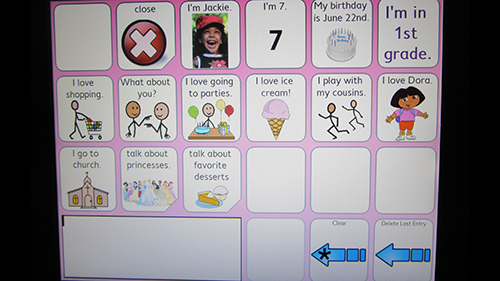Students need to have access to appropriate, meaningful vocabulary in order to participate, interact and learn new skills. Bridge School staff use Light and Binger’s (1998) procedures for vocabulary selection as well as evidence-based principles to select specific words and messages. Staff use the following procedure to select vocabulary:
- Collaborate with team members, including student and caregivers as appropriate.
- Generate a list of potential vocabulary using multiple approaches:
- Use environmental or ecological inventories.
- Ask parents, caregivers, or educational team members to keep a diary of vocabulary needs.
- Use published vocabulary checklists (e.g., MacArthur-Bates Communicative Developmental Inventories) to generate age-appropriate vocabulary.
- Observe typically-developing peers and/or siblings in similar communicative situations and note vocabulary used.
- Gather vocabulary from families using Home News, email correspondence and daily home-school notes.
- Collaborate with team members to identify vocabulary related to curriculum.
- Select priority vocabulary items for initial teaching.
- Suggest specific wording and modes for expression to student and educational team; modify as needed.

In selecting vocabulary, The Bridge School team is guided by the following principles:
- Vocabulary should be individualized, reflecting the interests and unique personality of the student.
- Vocabulary for a student should reflect same-aged typically developing peers in the student’s community.
- Students should be able to express a range of communicative and pragmatic functions using modes that are efficient for the student and easily interpreted by partners.
- The student should be involved in vocabulary selection whenever possible.
- Vocabulary selected should include ways for the student to direct partners, maintain conversational control, clarify messages and repair communication breakdowns.
- Staff should introduce new vocabulary concepts frequently, to keep pace with and constantly expand the student’s access to vocabulary and ability to express complex language.
- Students should have a way to request additional vocabulary (e.g., I need a new word, that’s not what I really meant, I don’t have a way to say it, etc.).
Tools and Resources
- Vocabulary selection questionnaire for older students [PDF, 147KB]
- Ecological Inventory [PDF, 178KB]
- 14 Fun Family Phrases [PDF, 72KB]
- Bridge School’s Recent Experience Log and All About Me Inventory
- Pat Dowden (University of Washington) website offers many resources and tools for gathering potential vocabulary
References
Beukelman, D. and Mirenda, P. (2013). Augmentative and Alternative Communication: Supporting children & adults with complex communication needs. Fourth Ed. Baltimore: Paul H. Brookes Publishing Co.
Fallon, K.A., Light, J.C., & Paige, T.K. (2001). Enhancing vocabulary selection for preschoolers who require augmentative and alternative communication (AAC). American Journal of Speech-Language Pathology, 10, 81-94.
Light, J.C. and Binger, C. (1998). Building Communicative Competence with Individuals Who Use Augmentative and Alternative Communication. Baltimore: Paul H. Brookes Publishing Co.

